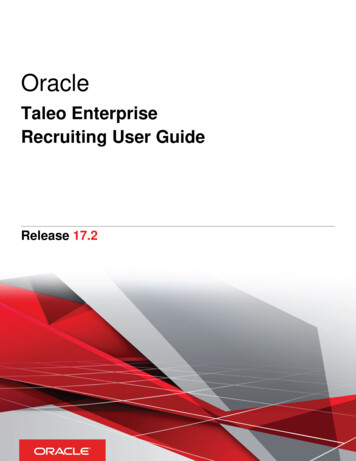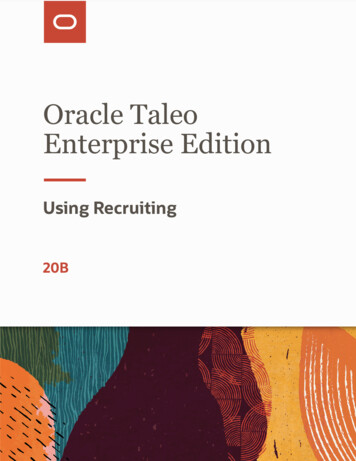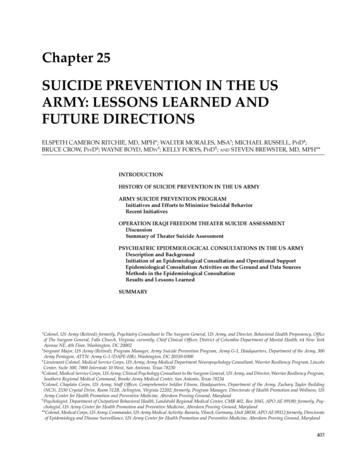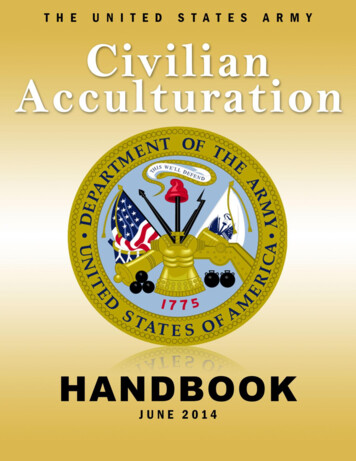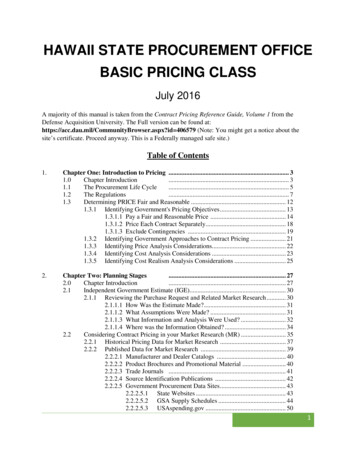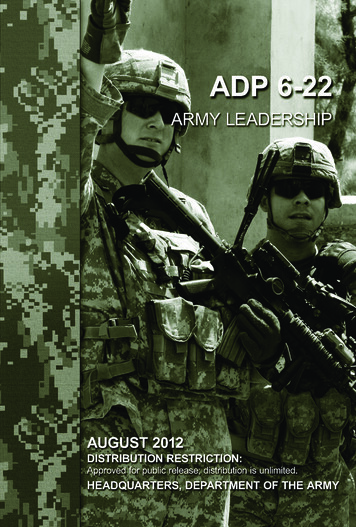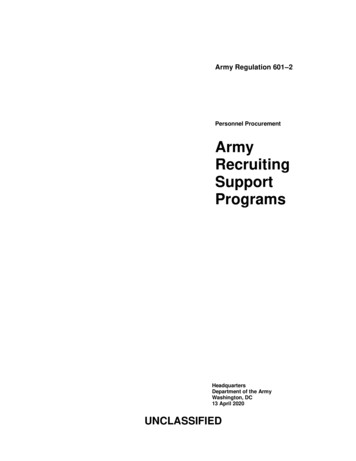
Transcription
Army Regulation 601–2Personnel rsDepartment of the ArmyWashington, DC13 April 2020UNCLASSIFIED
SUMMARY of CHANGEAR 601–2Army Recruiting Support ProgramsThis expedited revision, dated 13 April 2020 oEstablishes Commanding General, U. S. Army Training and Doctrine Command as senior responsible officer foraccessions planning and execution (para 1–10).oClarifies permissive temporary duty status, administrative procedures, and duties for Hometown Recruiter AssistanceProgram participation (chap 7).oChanges name of Recruiting, Retentions, and Strength Briefing to Accessions, Retention, and Strength Briefing (para9–2i).oModifies meeting and conferencing requirements for the Senior Management Forum for Accession (para 9–2g).oModifies description of the Accession General Officer Steering Committee (para 9–2h).
HeadquartersDepartment of the ArmyWashington, DC13 April 2020*Army Regulation 601–2Effective 13 May 2020Personnel ProcurementArmy Recruiting Support Programsotherwise stated. It also applies to the U.S.Military Entrance Processing Command,for Centers of Influence events that it initiates, in support of the Department of Defense Student Testing Program. Heads ofHeadquarters, Department of the Armyagencies and commanders of Army commands, installations, or activities must haveknowledge of AR 25–22 and AR 25–55.History. This publication is an expeditedrevision.Summary. This regulation establishespolicies and procedures for conducting the:Total Army Involvement in Recruiting Program; General Officer Sponsor Program;Educator/Centers of Influence Tour Program; Centers of Influence Events Program; Delayed Entry Program/ DelayedTraining Program functions; HometownRecruiting Assistance Program; Department of the Army Civilian Recruiting Program; Recruiting and Reserve PartnershipCouncil; and Army command and installation recruiting programs.Applicability. This regulation applies tothe Regular Army, the Army NationalGuard/Army National Guard of the UnitedStates, and the U.S. Army Reserve, unlessSupplementation. Supplementation ofthis regulation and establishment of command and local forms are prohibited without prior approval from the Deputy Chief ofStaff, G–1 (DAPE–MPA –RP), 300 ArmyPentagon, Washington, DC 20310–0300.Suggested improvements. Users areinvited to send comments and suggestedimprovements on DA Form 2028 (RecomProponent and exception authority.mended Changes to Publications and BlankThe proponent of this regulation is the DepForms) directly to the Deputy Chief ofuty Chief of Staff, G–1. The proponent hasStaff, G–1 (DAPE–MPA –RP), 300 Armythe authority to approve exceptions orPentagon, Washington, DC 20310–0300.waivers to this regulation that are consistentwith controlling law and regulations. The Committee management. AR 15–39proponent may delegate this approval au- requires the proponent to justify establishthority, in writing, to a division chief within ing/continuing committee(s), coordinatethe proponent agency or its direct reporting draft publications, and coordinate changesunit or field operating agency, in the grade in committee status with the Office of theof colonel or the civilian equivalent. Activ- Administrative Assistant to the Secretary ofities may request a waiver to this regulation the Army, Analysis and Integration Cellby providing justification that includes a (AAAI–CL), 105 Army Pentagon, Washfull analysis of the expected benefits and ington D.C. 20310–0105. Further, if it ismust include formal review by the activ- determined that an established "group"ity’s senior legal officer. All waiver re- identified within this regulation later takesquests will be endorsed by the commander on the characteristics of a committee asor senior leader of the requesting activity found in AR 15– 39, then the proponent willand forwarded through their higher head- follow AR 15–39 requirements for estabquarters to the policy proponent. Refer to lishing and continuing the group as a committee.AR 25–30 for specific guidance.Army internal control process. Thisregulation contains internal control provisions, in accordance with AR 11–2, andidentifies key internal controls that must beevaluated (see appendix B).Distribution. This publication is available in electronic media only and is intendedfor the Regular Army, the Army NationalGuard/Army National Guard of the UnitedStates, and the U.S. Army Reserve.Contents (Listed by paragraph and page number)Chapter 1Army Recruiting Support Programs, page 1Section IIntroduction, page 1Purpose 1–1, page 1References and forms 1–2, page 1Explanation of abbreviations and terms 1–3, page 1Responsibilities 1–4, page 1Records management (recordkeeping) requirements 1–5, page 1*This publication supersedes AR 601–2, dated 27 September 2016.AR 601–2 13 April 2020UNCLASSIFIEDi
Contents—ContinuedOverview 1–6, page 1Section IIResponsibilities, page 1Chief, National Guard Bureau 1–7, page 2Deputy Chief of Staff, G–1 1–8, page 2Chief, Army Reserve 1–9, page 2Commanding General, U.S. Army Training and Doctrine Command 1–10, page 2Commanders of Army Commands 1–11, page 2Chapter 2Total Army Involvement in Recruiting Program, page 3Objectives 2–1, page 3Policy 2–2, page 3Program responsibilities and procedures 2–3, page 4Chapter 3General Officer/Senior Executive Service Recruiting Support Program, page 5Objectives 3–1, page 5Policy 3–2, page 5Program roles and procedures 3–3, page 5Chapter 4Educator/Centers of Influence Tour Program, page 6Objectives 4–1, page 6Policy 4–2, page 6Program roles and procedures 4–3, page 6Chapter 5Centers of Influence Events Program, page 7Objective 5–1, page 7Event policies 5–2, page 7Program roles and procedures 5–3, page 8Chapter 6Delayed Entry Program/Delayed Training Program Gatherings, page 8Objectives 6–1, page 8Policy 6–2, page 9Program roles and procedures 6–3, page 9Chapter 7Hometown and Special Recruiter Assistance Program, page 9Objectives 7–1, page 9Policy 7–2, page 10Hometown Recruiter Assistance Program and procedures 7–3, page 10Special Recruiter Assistance Program and procedures 7–4, page 12Chapter 8Recruiting and Reserve Partnership Council, page 14Objectives 8–1, page 14Policy 8–2, page 14Program roles and procedures 8–3, page 15Common areas of interest 8–4, page 15Chapter 9Mission Support, page 17Objectives 9–1, page 17iiAR 601–2 13 April 2020
Contents—ContinuedPolicy 9–2, page 17Leader execution 9–3, page 19AppendixesA. References, page 21B. Internal Control Evaluation, page 23GlossaryAR 601–2 13 April 2020iii
Chapter 1Army Recruiting Support ProgramsSection IIntroduction1 –1. PurposeThis regulation establishes policy, responsibilities, and procedures for conducting the recruiting support programs reflectedin paragraph 1–6. It applies to recruiting support programs and related activities in support of the Army’s recruiting effortsacross all three Army components. This regulation reforms current practices by setting a standard for conducting recruitingsupport programs.1 –2. References and formsSee appendix A.1 –3. Explanation of abbreviations and termsSee the glossary.1 –4. ResponsibilitiesSee section II of this chapter.1 –5. Records management (recordkeeping) requirementsThe records management requirement for all record numbers, associated forms, and reports required by this regulation areaddressed in the Army Records Retention Schedule-Army (RRS–A). Detailed information for all related record numbers,forms, and reports are located in ARIMS/RRS–A at https://www.arims.army.mil. If any record numbers, forms, and reportsare not current, addressed, and/or published correctly in ARIMS/RRS–A, see DA Pam 25–403 for guidance.1 –6. Overviewa. The Total Army Involvement in Recruiting (TAIR) Program, whereby Army commands (ACOMs), field operatingagencies (FOAs), the Army National Guard of the United States, and the U.S. Army Reserve (USAR) furnish equipmentand personnel to the U.S. Army Recruiting Command (USAREC) and the U.S. Army Cadet Command (USACC), toparticipate in recurring and continued promotional activities that enhance attainment of the Total Army recruiting mission.The TAIR Program is focused on two basic campaigns—(1) Prospects (primary).(2) Army awareness (secondary).b. The General Officer Recruiting Support Program provides general officers the opportunity to support recruiting activities in their hometowns or alma maters, or during their official travels.c. The Educator/Centers of Influence (E/COI) Tour Program provides E/COI tours of Army installations and activitiesfor educators and “centers of influence,” which are groups or people that bolster the Army’s image or help influenceindividuals who are considering Army service.d. The Centers of Influence (COI) Events Program provides information on Army opportunities and options to COI.For the U.S. Military Entrance Processing Command (USMEPCOM), COI events provide information on the Departmentof Defense (DOD) Student Testing Program; in particular, the Armed Services Vocational Aptitude Battery (ASVAB)tests offered in the nation’s high schools.e. Delayed Entry Program (DEP)/Delayed Training Program (DTP) functions reinforce the commitment made by members of the Army’s DEP and DTP.f. The Recruiting and Reserve Partnership Council (R2PC) is a forum to establish a perpetual partnership, improvecommunications, and synchronize recruiting efforts between USAREC and USAR Command (USARC). The primaryfunction of this council is to enhance and improve recruiting activities in support of U.S. Army Reserve troop Programunits.Section IIResponsibilitiesAR 601–2 13 April 20201
1 –7. Chief, National Guard BureauThe CNGB will—a. Encourage State governments, through State Adjutants General, to support Total Army recruiting efforts as Statepriorities permit.b. Encourage States to provide resources (that is, equipment and manpower) of the Army National Guard (ARNG) tosupport Total Army recruiting and awareness efforts when RA and USAR resources have been exhausted or when significant cost efficiencies can be accommodated. The USAREC requirements on the ARNG will be coordinated through theAdjutant General in the state where the requirement exists. Coordination between USAREC and the National Guard Bureau(NGB) is not required.c. Encourage participation in recruiting conferences.1 –8. Deputy Chief of Staff, G –1The DCS, G–1 will—a. Establish policy for the conduct of the Regular Army (RA) and USAR promotional recruiting programs and provideguidance to USMEPCOM with regard to COI events in support of the DOD Student Testing Program.b. Monitor and ensure adequate funding for recruiting activities.c. Through the Commanding General, U.S. Army Human Resources Command (CG, HRC):(1) Provide key players to participate in the quarterly Acquire Portfolio Integrated Working Group (APIWG), as reflected in chapter 9 of this regulation.(2) Provide key players to participate in the monthly Multi-Component Accession Working Group (MCAWG), as reflected in chapter 9 of this regulation.1 –9. Chief, Army ReserveThe CAR will—a. Provide man-day space funding for USAR units and individuals to support recruiting efforts, as well as funding forUSAR-related TAIR, General Officer Speaker Program, E/COI tours, COI events, DTP functions, and U.S. Army MedicalDepartment (AMEDD) subject matter expert events.b. Encourage participation in recruiting-related conventions and events.c. Coordinate and execute R2PCs with CG, USAREC.d. See additional program responsibilities and procedures in chapters 2 through 9.1 –10. Commanding General, U.S. Army Training and Doctrine CommandThe CG, TRADOC, as the Senior Responsible Officer (SRO), is responsible for accessions planning and execution toeffectively plan, prioritize resources, execute, and exploit success.1 –11. Commanders, Army CommandsCommanders, ACOMs will—a. Support the recruiting mission of the RA and the USAR/ARNG as directed by this regulation. Direct subordinateunits to help with promotional recruiting support programs. Commanders can leverage the assigned Recruiting OutreachNCO (noncommissioned officer) to support the coordination and clear a path for all Army Recruiting Support Programs,if available.b. Conduct public affairs programs supporting promotional recruiting programs.c. Ensure that installation and activity commanders maintain a central coordination office responsible for processingsupport requests for all tenant units, and provide a point of contact to USAREC.d. Participate in recruiting support conferences. Ensure compliance with Army conference policy reflected in AR 15–39prior to determining participation at any recruiting conferences.e. Provide recruiting support from local resources whenever possible.f. Establish funding requirements to procure recognition items of nominal or modest value for recruitment purposes,and to present such items to members of the Army, their Family members, and other individuals recognized as providingsupport that significantly contributes to service recruitment. Ensure consistency in scope and value of recognition itemsacross the RA and USAR components.(1) Each recognition item provided under this policy will be valued at less than 50 per item, with items limited tocommemorative coins, medals, trophies, badges, flags, posters, paintings, or similar things designed to recognize or commemorate service in the Armed Forces.2AR 601–2 13 April 2020
(2) This guidance does not apply to existing programs where appropriated funds are used to purchase trinkets (forexample, pencils, magnets, computer mouse pads) distributed for recruiting purposes.g. Explain and promote the RA, ARNG, and USAR to both public and command information audiences.h. Provide recruiting information to installations (and all general officer level commands) for use in speakers’ kits.i. Provide public affairs assets to recruiting battalions, and promote the positive story such assets produce.j. Conduct frequent installation tours for groups of E/COIs and prospects.k. Respond to support requests made within time frames given in paragraph 2–3d.l. Provide timely responses to USAREC requests for support as stated in paragraph 2–3d. Cancellations of previouslyapproved assets must be minimized in order for recruiters to maintain their credibility in communities.m. Ensure support personnel participating in promotional recruiting projects are properly briefed or rehearsed prior totheir presentation.n. Provide to USAREC information for establishing a digital library of available TAIR assets.o. Promote access to Army clubs, theaters, and other recreational facilities for recruiters, E/COIs, and prospects.p. The CG, USAREC will coordinate, execute, and monitor the R2PCs in accordance with guidance provided in chapter8.q. See additional program responsibilities and procedures in chapters 2 through 9.Chapter 2Total Army Involvement in Recruiting Program2 –1. ObjectivesThe objectives of the TAIR program are to—a. Help maintain the authorized RA and USAR personnel strength and readiness.b. Help recruit specific military occupational specialties (MOSs), and attain the high school diploma graduate and TestScore Category I–IIIA recruiting goals each fiscal year.c. Help recruit specific military areas of concentration (AOCs) and attain the Medical College Admission Test (MCAT)and the Dental Admission Test (DAT) to support AMEDD recruiting goals each fiscal year.d. Improve the Army’s image through the use of promotional assets that increase awareness and interest in Army opportunities.e. Help maintain coordination between the recruiting force, the Army Staff, the Army in the field, the ARNG, and theUSAR.2 –2. Policya. Under the operational control of the SRO, prospect and awareness campaign synchronization and execution planningwill be processed through the TRADOC Fusion Board. Two basic campaigns will be conducted under the TAIR program,in order of priority, as follows:(1) Prospect Campaign. These activities will be conducted to reach the primary recruiting audience in high schools,trade schools, community colleges, colleges, universities, pre-med, healthcare professional career schools, and similarsettings. The activities include MOS skill clinics, AOC speaking engagements, lecture programs and demonstrations; staticdisplays such as communications equipment, radar equipment, deployable rapid assembly shelter and vehicles; and ACOMexhibits. They also include sports clinics, job fairs, and orientation tours of military installations for RA and USAR enlisteeprospects and medical officer prospects. Orientation tours are not to be confused with annual summer training encampments or drill competition for Junior Reserve Officers’ Training Corps students. Orientation tours must be initiated,planned, and conducted by USAREC elements with recruiters present throughout the tour. The TAIR projects are not tobe confused with other ongoing or special programs conducted by commands other than USAREC, which are not part ofthe TAIR program.(2) Army Awareness Campaign. These activities will be used to reach the general public through participation in publicactivities such as parades, fairs, festivals, community celebrations, military open-house functions, job fairs, and publicmeetings. These activities may include military equipment displays and presentations; demonstration units such as Rangers, drill teams, and sports demonstration teams; and ACOM exhibits. They may also include speaker programs with general officers and other prominent spokespersons of Army bands and ceremonial units.b. The ACOMs, FOAs, and USAR will provide maximum support to all elements of USAREC in executing the RAand USAR recruiting mission. When RA and USAR resources have been exhausted or when significant cost efficienciescan be made, local recruiters may request ARNG resources through the Adjutant General in the states where the requirement exists.AR 601–2 13 April 20203
c. The ACOMs and FOAs will provide recruiting support and inform USAREC of funding requirements.d. Personnel and equipment involved in TAIR projects will be from units other than USAREC.e. Because role models are important to young Americans, units supporting TAIR projects may give priority to participants who can be strong role models for the audience.f. Units whose first priority is to support the recruiting brigade boundaries where they are located will give secondpriority to other recruiting brigades, as requested.g. As exceptions to the recruiting brigade boundary rule, units will give second priority for support to the recruitingbrigade in which they are geographically located, and tertiary support to all other recruiting brigades, as requested.2 –3. Program responsibilities and proceduresa. USAREC will establish operational and administrative procedures to request TAIR support from all supporting units.b. Whenever possible, the processing of assets from supporting units should be requested though the Recruiting Outreach NCO if available. This can ensure effective communication and ensure the supporting units’ resources meet theobjectives of the campaign.c. Early coordination between recruiting brigades or recruiting battalions and supporting units will be effected to facilitate early commitment of TAIR assets and processing of TAIR funding documents. For USAR units, the request will berouted through the unit’s Major General Command Headquarters.d. Recruiting brigade and battalion requests for TAIR support will be forwarded to arrive at the supporting unit not lessthan 45 calendar days prior to the project start date.e. Supporting units will respond to requests for TAIR support not less than 30 calendar days prior to the project startdate.f. Scheduling commitments will not be made until the supporting unit or installation has agreed to provide the requestedsupport and any required approval has been obtained. Commitments made to civilian communities and sponsors must behonored whenever possible.g. Factors that will be considered in determining the priorities and requirements to use promotional resources are asfollows:(1) Headquarters, Department of the Army policy.(2) Impact on mission.(3) Availability of resources.(4) Target audience.(5) Cost effectiveness and efficiency.(6) Density of promotional support in the area.(7) Weather conditions that may affect use of promotional resources.h. Requests for Active Duty for Operational Support (ADOS) funds, required to employ USAR personnel in TAIRprojects, will be processed according to established USAREC and USAR policies. The TAIR funds will be used to supportTAIR projects conducted by USAREC. The TAIR funds will not be used for ongoing or special programs conducted orinitiated by other commands—unless those projects are in the best interest of the Army recruiting effort, as determined byUSAREC.i. The TAIR funds may be used to fund travel and per diem, and to reimburse units for fuel, maintenance costs, andother services incurred as a result of USAR and ARNG participation in TAIR projects.j. The ARNG ADOS funds are not available for ARNG personnel through USAREC channels. The TAIR funds cannotbe used for this purpose.k. The ADOS funds allocated to USAREC may be used for USAR personnel participating in TAIR projects when fundsare available and the project qualifies for such funding. When ADOS funding is not available through USAREC or theUSAR unit, USAR assets and personnel may participate during periods of inactive duty training if the TAIR project directlyenhances unit training or individual training.l. Costs of TAIR projects must be agreed upon between USAREC and the supporting unit. Failure to ensure that adequate funds are available may result in a violation of Section 1517, Title 31, United States Code (31 USC 1517) andDFAS–IN Regulation 37–1.m. The TAIR projects will be funded by Defense Travel System (DTS) cross line accounting, via the USAREC requesting agency.n. If funding of travel and transportation, or per diem, is not required all other costs will be reimbursed via the GeneralFund Enterprise Business System transfer.o. Supporting units will process orders via DTS using a USAREC cross line accounting. Requests and approvals forADOS and TAIR funds, and related documents, will be filed electronically for 2 years after the event has occurred, andthen the documents are destroyed.4AR 601–2 13 April 2020
Chapter 3General Officer/Senior Executive Service Recruiting Support Program3 –1. ObjectivesThe objectives of the General Officer/Senior Executive Service (SES) Recruiting Support Program are as follows:a. Increase general officer/SES involvement in the recruiting effort.b. Improve the understanding of, and support for, service in the Army and motivate all Army members to help therecruiting effort.c. Help publicize enlistment and commissioning opportunities and the advantages of Army service to influencers andprospects.d. Provide high level recognition of recruiter’s efforts to meet recruiting goals.e. Develop new platforms and better methods to convey the Army’s recruiting message to COIs and prospects.f. Improve relationships within local communities, the high school and college markets, and the healthcare student andprofessional markets; and improve awareness of Army opportunities within applicable demographics and national organizations.g. Maintain the involvement of RA and USAR general officers in support of USAREC’s Total Army recruiting objectives.3 –2. Policya. General officers and SES members will be invited to recruiting battalion activities in and around their hometownsand high school or college alma maters, as well as other areas where they can make an impact in the community.b. General officers and SES members invited to participate in recruiting activities should have an appropriate connection, such as a “historical or business tie” with the geographical area of the recruiting battalion.c. General officer and SES sponsors may be asked to:(1) Participate in recruiting battalion’s annual training conferences or award presentations to help motivate recruitersby recognizing their efforts.(2) Address civic groups, organizations, high schools and/or colleges, area educators, and other COI to improve therecruiting program.(3) Encourage area community and business leaders to support local Army recruiting efforts.(4) Participate in Partnership for Youth Success (PaYS) signing events or community leader events to increase awareness of the PaYS program.(5) Address future Soldiers and their Family members at Future Soldier Training Program activities, to encourage andthank them for answering the call to duty.(6) Help improve relationships with high schools and colleges, especially those they attended, and improve awarenessof Army opportunities.d. Other senior Army leaders, as well as Civilian Aides to the Secretary of the Army (CASAs), and USAR Ambassadorsmay also be asked to participate in the Recruiting Support Program.e. Personnel attending general officer presentations will be selected based on the following order:(1) Primary COIs for high school seniors, graduates, their parents, educators, and counselors.(2) College students and faculty.(3) Community and business leaders.(4) Media reaching high school seniors, graduates, parents, and influencers.(5) Potential applicants who are high school seniors and graduates.(6) National and/or regional level organizations (veteran/civic).3 –3. Program roles and proceduresa. The USAREC—(1) Identifies speaking and support opportunities, and invites the appropriate general officers to give support.(2) Coordinates with the general officer’s staff to develop an itinerary and arrange administrative and logistical supportfor the officer’s participation in the recruiting support activities. Additional support is provided by the Recruiting OutreachNCO, if available.(3) Provides the general officer with relevant data on:(a) Current mission and accomplishments, recruiting battalion organization, and strength.(b) The recruiting environment.(c) The type of recruiting support needed by the local recruiters.AR 601–2 13 April 20205
(d) Other support in which the general officer may be able to assist.b. To encourage other general officer sponsor involvement, the USAREC—(1) Coordinates with the appropriate General Officer Management Office (RA or Office, Chief of the Army Reserve)(DACS–GOM) to maintain a current list of general officers, to include promotable colonels, stationed in the United Statesor it Territories.(2) Coordinates with the Office of the Chief, Public Affairs to maintain a list of CASAs.(3) Coordinates with the Office, Chief of the Army Reserve (OCAR) to maintain a list of Reserve Ambassadors.(4) Formally invites appropriate individuals to recruiting activities and events.Chapter 4Educator/Centers of Influence Tour Program4 –1. ObjectivesThe objectives of E/COI tours in support of RA and USAR recruiting are to—a. Provide tours of Army installations, medical treatment facilities, and activities for educators and other centers ofinfluence.b. Pass the following messages to E/COI:(1) Education and training opportunities in the Army are excellent, and Soldiers are encouraged to continue their education.(2) The Army is a choice that should be considered by every graduating high school senior and every healthcare studentor professional.(3) The Army is genuinely interested in the welfare and development of its Soldiers.(4) Many students have limited knowledge of Army opportunities.(5) The Army consists of competent, well-trained, and proud multiskilled leaders who can perform critical functionsfrom warfighting to statesmanship to business management.c. Directly support the recruiting effort by seeking improved access to schools, directory information, MCAT and DATlists, students, graduates, and the scheduling of the ASVAB that is offered by the DOD Student Testing Program administered by USMEPCOM.4 –2. Policya. The cost of this program will be minimized by conducting E/COI tours within USAREC recruiting brigade boundaries, at the most appropriate installation or medical treatment facility attracting the highest number of participants.b. Group size for educator tours should be the minimum acceptable to the host installation, generally, not fewer than14 E/COI and 2 USAREC escorts, and not more than 50 E/COI with 3 escorts.c. Although students should not normally be included on educator tours, key students who are clearly COIs may beinvited on a case-by-case basis.d. Army retirees and members of the RA, USAR, and ARNG who are already familiar with Army opportunities willnot normally be included as tour participants.e. Tours may include some pro-Army participants, but the majority should be open-minded neutrals and undecidedCOI.f. Emphasis should be on including “key COI” such as counselors, principals and school board members; presidents ofprofessional organizations, deans of medical schools, and financial aid advisors who can later testify to the quality of Armyskills, technical training, and well-being of young enlisted Soldiers and medical officers they have met; and those who caninitiate support within their school systems after participating in tours.g. USAREC will have oversight and approve any request to conduct E/COI tours outside of a USAREC recruitingbrigade boundary.4 –3. Program roles and proceduresa. The USAREC—(1) Determines the targeted invitee group and the month and week when the invitees will be available and most likelyto participate.(2) Determines the most appropriate site within USAREC recruiting brigade boundaries that will attract the largestnumber of the targeted group, according to location and availability of tour.(a) Contacts the installation’s tour coordinator and determines an acceptable itinerary.(b) Identifies available lodging, transportation, and their costs.6AR 601–2 13 April 20
The Educator/Centers of Influence (E/COI) Tour Program provides E/COI tours of Army installations and activities for educators and "centers of influence," which are groups or people that bolster the Army's image or help influence individuals who are considering Army service.

